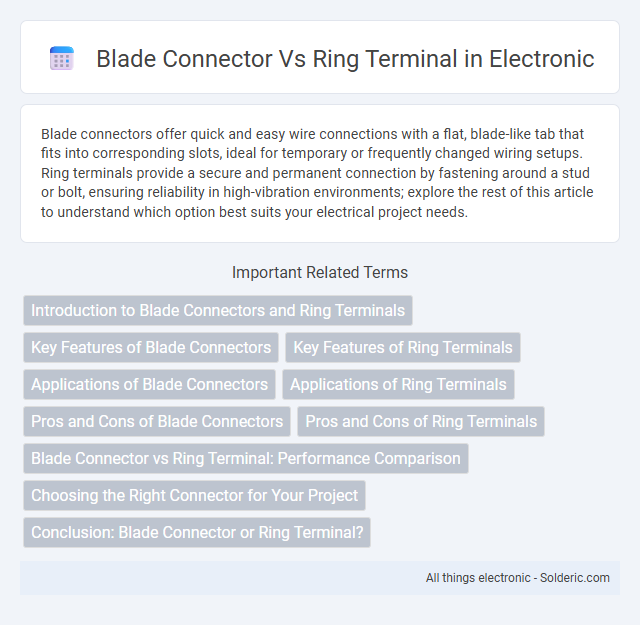Blade connectors offer quick and easy wire connections with a flat, blade-like tab that fits into corresponding slots, ideal for temporary or frequently changed wiring setups. Ring terminals provide a secure and permanent connection by fastening around a stud or bolt, ensuring reliability in high-vibration environments; explore the rest of this article to understand which option best suits your electrical project needs.
Comparison Table
| Feature | Blade Connector | Ring Terminal |
|---|---|---|
| Connection Type | Quick-disconnect blade | Bolted or screwed ring |
| Installation | Slide-on, tool-free | Requires screw or bolt fastening |
| Use Case | Frequent disconnections, automotive, electronics | Permanent, secure electrical grounding and power connections |
| Durability | Moderate, prone to loosen over time | High, strong mechanical hold |
| Current Capacity | Varies by size, suitable for moderate currents | Typically supports higher current ratings |
| Material | Copper or brass with plating | Copper or brass with plating |
| Typical Applications | Automotive wiring, appliance connections | Grounding systems, battery terminals, industrial wiring |
Introduction to Blade Connectors and Ring Terminals
Blade connectors are flat, rectangular metal terminals designed for quick, secure connections in automotive and electrical wiring. Ring terminals feature a circular opening that fits over a screw or stud, providing a reliable, vibration-resistant connection in various applications. Understanding the differences between these connectors helps you choose the right terminal for your electrical system's safety and efficiency.
Key Features of Blade Connectors
Blade connectors feature a flat, rectangular metal blade that inserts into a matching female connector, providing quick and secure connections widely used in automotive and electrical wiring. They offer easy disconnection without tools, excellent conductivity, and resistance to corrosion when paired with proper insulation materials. Blade connectors come in various sizes and current ratings to accommodate diverse applications and improve wiring system efficiency.
Key Features of Ring Terminals
Ring terminals offer secure connections with a circular metal ring that fits snugly over a bolt or stud, ensuring reliable electrical conductivity and preventing disconnection. They are ideal for high-vibration environments due to their sturdy design and ability to distribute mechanical stress evenly around the connection point. Your wiring setup benefits from the ease of installation and maintenance that ring terminals provide, especially in automotive and industrial applications.
Applications of Blade Connectors
Blade connectors are widely used in automotive wiring harnesses, providing secure and quick connections for power and signal transmission. Their flat, rectangular design allows easy insertion and removal in tight spaces, making them ideal for circuit boards, battery terminals, and automotive electrical systems. Blade connectors offer reliable conductivity and are commonly found in household appliances, industrial equipment, and automotive applications where frequent disconnection is required.
Applications of Ring Terminals
Ring terminals are widely used in automotive, marine, and industrial electrical applications for secure, reliable connections to screw or stud-type terminals. They provide a strong mechanical bond and excellent vibration resistance, making them ideal for grounding wires and high-current circuits. Their design ensures a stable connection that minimizes the risk of disconnection or electrical failure in harsh environments.
Pros and Cons of Blade Connectors
Blade connectors offer a quick and reliable way to connect wires, making them ideal for automotive and electrical applications needing frequent disconnections. Their pros include ease of installation, solid electrical contact, and compatibility with insulated terminals, but they can be less secure against vibration and accidental disconnection compared to ring terminals. Understanding these advantages and limitations helps you choose the best connector type for your wiring project's safety and durability needs.
Pros and Cons of Ring Terminals
Ring terminals provide a secure, reliable connection by enclosing a stud or screw, reducing the risk of disconnection from vibration or movement. Their main downside is the need for precise screw or stud sizing and more time-consuming installation compared to blade connectors, which simply slide onto terminals. Your choice depends on whether you prioritize durability and stability (ring terminals) or speed and ease of use (blade connectors).
Blade Connector vs Ring Terminal: Performance Comparison
Blade connectors offer quick connect and disconnect capabilities with reliable conductivity, ideal for applications requiring frequent maintenance or modifications. Ring terminals provide a secure, vibration-resistant connection, ensuring long-term stability in harsh environments or high-vibration settings. Your choice between blade connectors and ring terminals should consider factors like connection durability, ease of installation, and environmental conditions to optimize electrical performance.
Choosing the Right Connector for Your Project
When selecting between a blade connector and a ring terminal for your project, consider the application's electrical load and ease of connection. Blade connectors offer quick insertion and removal, making them ideal for temporary or frequently serviced connections, while ring terminals provide a secure, vibration-resistant connection perfect for high-vibration environments. Ensuring the connector matches your wire gauge and terminal post size is crucial for optimal conductivity and long-term reliability.
Conclusion: Blade Connector or Ring Terminal?
Blade connectors offer quick disconnect capabilities and are ideal for applications requiring easy maintenance or frequent component changes. Ring terminals provide a secure, vibration-resistant connection, making them suitable for permanent or high-vibration environments. Your choice depends on whether you prioritize ease of removal or long-term reliability in your electrical connections.
Blade Connector vs Ring Terminal Infographic

 solderic.com
solderic.com